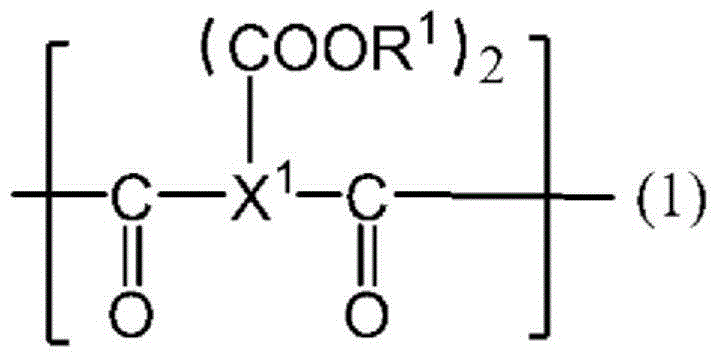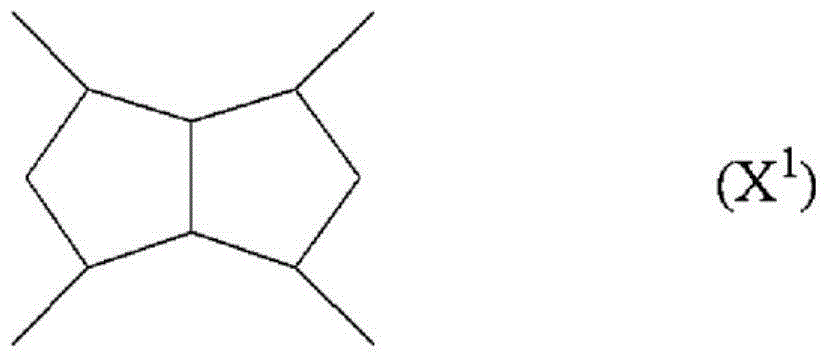Liquid crystal aligning agent for in-plane switching
A technology of transverse electric field and liquid crystal alignment, applied in the direction of instruments, optics, nonlinear optics, etc., can solve the problems of peeling, affecting, and damaging the performance of liquid crystal alignment film, and achieve the effect of excellent adhesion
- Summary
- Abstract
- Description
- Claims
- Application Information
AI Technical Summary
Problems solved by technology
Method used
Image
Examples
Embodiment
[0137] The following examples are given to illustrate the present invention in more detail, but the present invention is not limited to these examples. The abbreviations used in the following Examples and Comparative Examples are as follows.
[0138]
[0139] CA-1: 1,2,3,4-cyclobutanetetracarboxylic dianhydride
[0140] CA-2: Bicyclo[3.3.0]octane-2,4,6,8-tetracarboxylic dianhydride (the content of isomer [IV] is 97%)
[0141] CA-3: pyromellitic dianhydride
[0142] CA-4: 3,4-dicarboxy-1,2,3,4-tetrahydro-1-naphthalene succinic dianhydride
[0143]
[0144] DA-1: 1,5-bis(4-aminophenoxy)pentane
[0145] DA-2: 3,5-diaminobenzoic acid
[0146] DA-3: N-(3-pyridylmethyl)-3,5-diaminobenzamide
[0147] DA-4: 3-aminobenzylamine
[0148] DA-5: p-phenylenediamine
[0149] DA-6: 1,3-Diamino-4-n-dodecyloxybenzene
[0150] DA-7: 4,4’-Diaminodiphenylmethane
[0151] DA-8: 4,4’-Diaminodiphenylamine
[0152]
[0153] BCS: Butyl Cellosolve
[0154] NMP: N-methyl-2-pyrrolidone
...
Synthetic example 1
[0166] DA-1 (14.32g, 50.0mmol), DA-2 (4.56g, 30.0mmol), DA-3 (4.85g, 20.0mmol) and CA-2 (12.51g, 50.0mmol) in NMP (207.4g) Mix in medium and react at 50°C for 6 hours. Then, CA-1 (9.51g, 48.5mmol) and NMP (51.9g) were added, it was made to react overnight at 40 degreeC, and the polyamic-acid solution (1) whose resin solid content concentration was 15 mass % was obtained.
[0167] After adding NMP to the obtained polyamic-acid solution (1) (100.0g) and diluting to 5 mass %, acetic anhydride (22.41g) and pyridine (8.69g) were added as an imidization catalyst, and it was made to react at 50 degreeC for 2 hours. This reaction solution was poured into methanol (1500 ml), and the resulting precipitate was collected by filtration. This deposit was wash|cleaned with methanol, it dried under reduced pressure at 100 degreeC, and obtained the polyimide powder (1). The imidization rate of this polyimide was 50%, the number average molecular weight was 24,800, and the weight average mole...
Synthetic example 2
[0169] DA-1 (18.61g, 65.0mmol), DA-2 (5.93g, 39.0mmol), DA-3 (6.30g, 26.0mmol) and CA-2 (24.40g, 97.5mmol) in NMP (195.3g) Mix in medium and react at 50°C for 6 hours. Then, CA-1 (5.79g, 29.5mmol) and NMP (48.8g) were added, it was made to react overnight at 40 degreeC, and the polyamic-acid solution (2) whose resin solid content concentration was 20 mass % was obtained.
[0170]After adding NMP to the obtained polyamic-acid solution (2) (100.0g) and diluting to 5 mass %, acetic anhydride (10.87g) and pyridine (8.43g) were added as an imidation catalyst, and it was made to react at 90 degreeC for 2.5 hours. This reaction solution was poured into methanol (1500 ml), and the obtained precipitate was collected by filtration. This deposit was wash|cleaned with methanol, and it dried under reduced pressure at 100 degreeC, and obtained the polyimide powder (2). The imidization rate of this polyimide was 50%, the number average molecular weight was 24,800, and the weight average mo...
PUM
 Login to View More
Login to View More Abstract
Description
Claims
Application Information
 Login to View More
Login to View More - R&D
- Intellectual Property
- Life Sciences
- Materials
- Tech Scout
- Unparalleled Data Quality
- Higher Quality Content
- 60% Fewer Hallucinations
Browse by: Latest US Patents, China's latest patents, Technical Efficacy Thesaurus, Application Domain, Technology Topic, Popular Technical Reports.
© 2025 PatSnap. All rights reserved.Legal|Privacy policy|Modern Slavery Act Transparency Statement|Sitemap|About US| Contact US: help@patsnap.com



